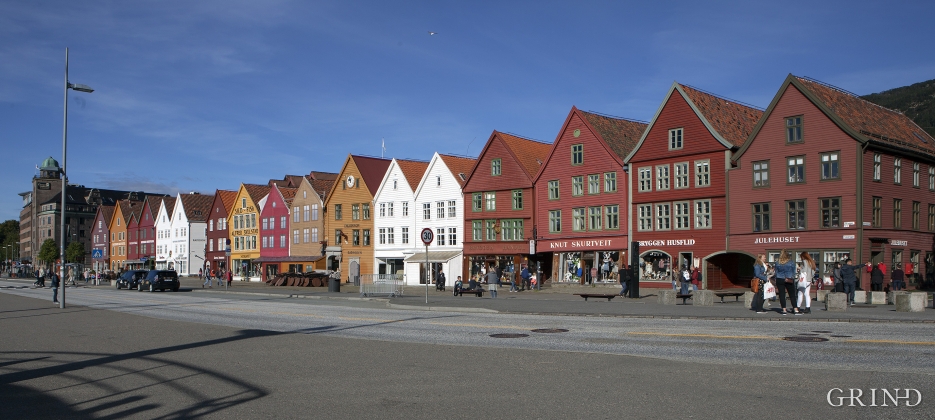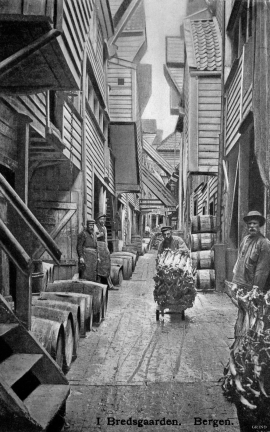Published: 24.01.2013 | Author: Per Jahn Lavik
In the 1300s Bergen was a trading centre of European dimension. The town is thought to have had around 7000 inhabitants and was the largest and most important in the country. In a European context it was an average size town. At this time the most tightly built town area was still mostly east of Vågen from Holmen in the north to Vågsbotn in the south. Already in medieval times, latest in the 1340s, this area was called Bryggen.
In the Bryggen area, between Sandbru and Auta-Almenning, there were about 30 tenements around 1300. In addition there were the tenements in Øvrestretet and in Vågsbotn. But some tenements were also starting to be raised on the Strand (beach) side west of Vågen.
Two longitudinal street passages led trough the town, Øvrestretet (the upper street) at the back and the foremost passage across Bryggen with continuation into Sutarestretet (King Oscar’s street). They were connected across common areas and narrow ditches. The buildings on Bryggen consisted mainly of double tenements; two long parallel rows of two or three storied houses, with a joint passageway in between. There were also single tenements with only one row of houses. The town was built mainly in wood. Bryggen, with its sea houses was the main area for activities connected with distant and retail trading. A tenement on Bryggen had buildings and rooms that served several purposes. On the ground floor there were mainly storage space, with living quarters and day rooms at the back. Here were the communal rooms for the households of the tenement, scullery and an inn (“Schötstue”) and rooms for brewing beer.
The Hanseats
Around 1360 the Hanseatic Association established an Office on Bryggen in Bergen, one of four foreign offices. With their own judicial authority, strict organisational rules and hard discipline, the Germans created their own society in the Bergen town milieu. The Germans came to dominate Bryggen for more than four hundred years. Trading in dried fish and corn was the basis for their activity.
The German quarters were situated in the oldest town area on the east side of Vågen, in the district from Maria-almenningen to Auta-almenningen (Vetrlidsalmenning). The first German winter residents hired lodgings from the Norwegian tenement owners in the central Bryggen area. From the second part of 1200 the Germans increasingly came to own houses in the trading quarters. The property rights to the houses were however normally separate from the property rights to the site. As long as the Office existed the Germans paid site rent to the Norwegian site owners. Around 1500 the main part of the properties was in German ownership.
The German colony probably counted around 1000 persons, but in the high season in the summer there could be as many as 2000 Germans, including merchants and seamen who resided there temporarily. The colony was a pure male society. The strict rules of the Office required that they lived in celibacy. It was forbidden to get married as long as one lived at the Office, and only unmarried men were granted residency.
The merchant’s hall was the administrative centre and gathering place for the merchants. This was where the secretary lived and this is where the courthouse, the Office’s archives and a large meeting room also were situated. The merchant’s hall was centrally placed in the middle of Bryggen, close to the town’s wine cellar and market place, by the place later known as Nikolaikirkealmenning. The Office in Bergen also came to have their own churches and a guild. The most important parish church for the Germans in Bergen was Mariakirken.
Fiskehandel på Bryggen
Dried fish comprised around 90% of exported goods from Bergen in medieval times. The trading with fish has been the mainstay in the business on Bryggen through the centuries.(photo: unknown, owner: Billedsamlingen, Universitetsbiblioteket i Bergen.)
- Andersson, E. B., Helle, K., Trebbi, M. & Wiberg, H. (1981) Bryggen: Hanseatenes Kontor i Bergen. Det Hanseatiske Museums skrifter, nr. 23. Bergen.
- Herteig, A. E. (1969) Kongers havn og handels sete: fra de arkeologiske undersøkelser på Bryggen i Bergen 1955-68. Oslo, Aschehoug.
- Håndbok i middelaldersk kulturhistorie: som supplement til utstillinger i Bryggens Museum (1976). Bergen, Bryggens Museum.
- Onsdagskvelder i Bryggens museum (1985-). Bergen, Bryggens Museum.





